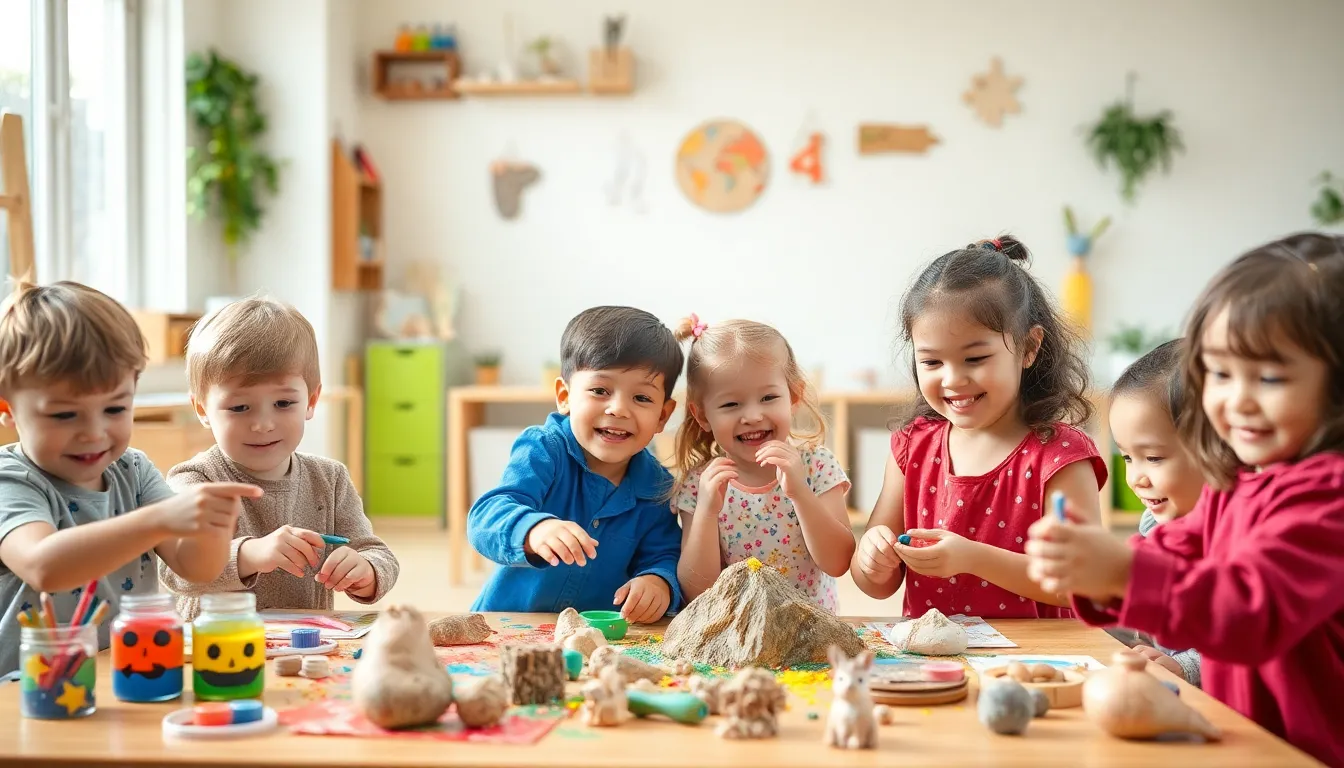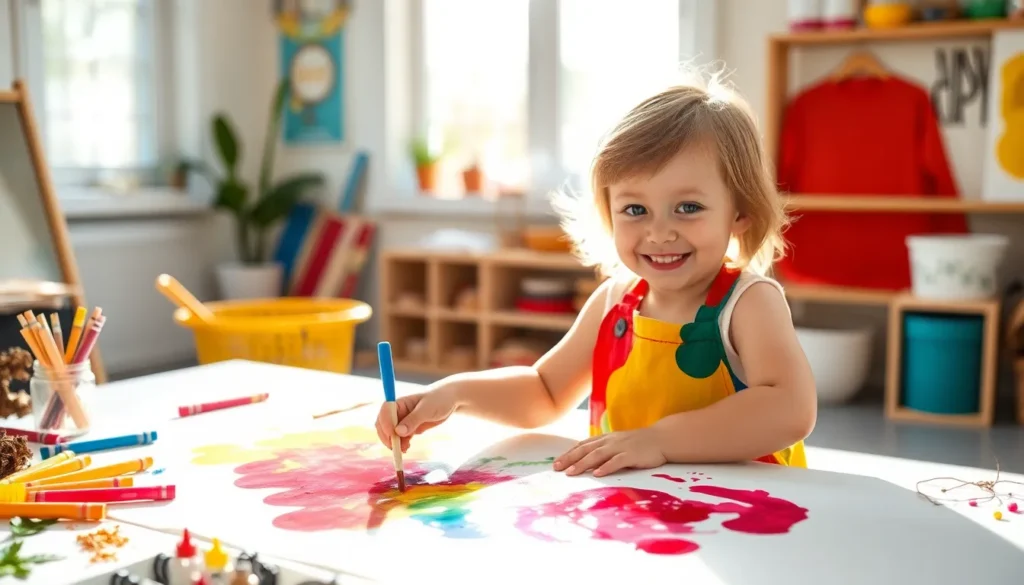Table of Contents
ToggleIn the colorful world of preschool, process art is the secret sauce that turns little Picassos into creative geniuses. Forget about perfecting a masterpiece; it’s all about the journey, not the destination. Kids dive into a world where paint splatters, glue sticks, and glitter reign supreme, allowing their imaginations to run wild.
Understanding Process Art Preschool
Process art emphasizes exploration and creativity in preschool settings. This approach allows children to engage with materials, fostering their artistic development in a supportive environment.
What Is Process Art?
Process art refers to an artistic practice focused on the experience of creating rather than the end result. Children interact with various materials like paint, crayons, and clay, encouraging spontaneous creativity. This form of art is sensory-based, allowing kids to explore textures, colors, and techniques. Furthermore, it’s about individual expression, enabling each child to represent their unique ideas and emotions without fear of judgment.
Benefits of Process Art in Preschool
Process art offers numerous benefits in preschool environments. It enhances fine motor skills through manipulation of materials. Children experience improved problem-solving abilities as they navigate their artistic choices. Social skills also develop as kids collaborate and share ideas during group activities. Emotional expression finds a platform, allowing children to communicate feelings visually. Ultimately, process art builds confidence, encouraging children to take risks and embrace their creativity in a supportive setting.
Key Elements of Process Art

Process art thrives on specific elements that foster creativity and learning in preschool settings. These elements contribute to a child’s artistic journey and development.
Open-Ended Materials
Open-ended materials are vital in process art. Items like paper, paints, clay, and natural objects provide endless possibilities for exploration. These materials encourage children to manipulate and experiment freely, engaging their imaginations. Unlike structured projects, open-ended options promote personal interpretation, allowing children to express their ideas uniquely. For instance, providing varied colors or textures can spark different creative pathways. When children interact with these materials, they gain confidence in their decision-making abilities and artistic expression.
Child-Led Exploration
Child-led exploration forms the backbone of process art. This approach emphasizes the child’s autonomy in discovering their interests and methods. Children drive their own creative processes, choosing how to engage with materials. For example, a child might decide to mix colors to create new shades or experiment with different tools like brushes and sponges. Self-directed exploration reinforces problem-solving skills and nurtures curiosity. As they explore, children learn to navigate challenges and celebrate their discoveries, fostering a deeper connection with the artistic process. This supportive environment empowers them to take ownership of their creations.
Activities for Process Art Preschool
Engaging in process art activities allows preschoolers to explore their creativity while enjoying hands-on experiences. The following activities promote creativity, experimentation, and self-expression among young children.
Painting with Natural Materials
Nature provides a wealth of inspiration and materials for painting activities. Children can gather leaves, twigs, flowers, and stones to use as painting tools. Using these items, they create unique textures and patterns. Instead of traditional brushes, they can dip leaves in paint and stamp them onto paper, developing their fine motor skills. This activity encourages observation of natural textures and colors, deepening their connection to the environment. Artists show their personalities through the designs, celebrating individual creativity.
Collage Making with Recycled Items
Recycled materials transform into vibrant collages that inspire creativity in preschoolers. Collecting items like cardboard, magazine scraps, fabric pieces, and bottle caps facilitates imaginative expression. Children can glue these elements onto a base, fostering exploration of composition and layering. By mixing and matching various textures and colors, they enhance visual awareness. This activity not only emphasizes sustainability but also encourages teamwork as children can collaborate on large collages, showcasing their ideas while improving social skills. Each collage becomes a reflection of their experiences and thoughts.
Tips for Educators and Parents
Creating an engaging process art experience is vital for children. Educators and parents can use simple strategies to enhance creativity and foster exploration.
Creating a Process Art-Friendly Environment
Establish a designated art space that encourages exploration. Use open-ended materials like paints, paper, and natural objects so children can experiment freely. Display work-in-progress art to promote a sense of community and collaboration. Good lighting and easy access to supplies enhance comfort and motivation. Provide different working surfaces to accommodate various activities and preferences. Clutter-free environments encourage focus, enabling children to delve into their creative processes unencumbered.
Encouraging Creativity and Independence
Allow children to make choices about their artistic processes. Offer prompts and ideas but encourage personal interpretation, fostering unique expression. Rotate materials regularly to keep experiences fresh and spark imagination. Facilitate collaborative projects to develop teamwork skills while celebrating individual creativity. Brief discussions about their creations can enhance their confidence in sharing their thoughts. Celebrating process over product nurtures their independence, providing them the freedom to explore without fear of judgment.
Embracing process art in preschool settings transforms the way children engage with creativity. By prioritizing the journey of creation over the final outcome, young learners gain invaluable skills and confidence. This approach fosters a rich environment where exploration and self-expression thrive.
Through hands-on activities and open-ended materials, children develop fine motor skills and problem-solving abilities while learning to collaborate with peers. The supportive atmosphere nurtures emotional expression, allowing them to communicate their feelings through art.
Ultimately, process art not only enhances artistic development but also cultivates a love for creativity that can last a lifetime. By championing this method, educators and parents empower children to explore their imaginations freely, laying the foundation for future creative endeavors.





